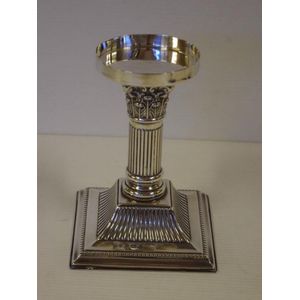Louis XVI Style Figural Clock with Cupid and Woman
A Louis XVI style spelter figural clock, 19th century, with maker's marks for Franju and C Raison to mechanism, depicting a seated woman reading and a cupid figure beside a mirror and slipper, the black marble dial with Roman numerals and raised on an extended, waisted base with cupids and neoclassical elements, with key and pendulum, height 50 cm, width 45 cm, depth 16 cm
You must be a subscriber, and be logged in to view price and dealer details.
Subscribe Now to view actual auction price for this item
When you subscribe, you have the option of setting the currency in which to display prices to $Au, $US, $NZ or Stg.
This item has been sold, and the description, image and price are for reference purposes only.
- Pendulum - The pendulum was discovered around 1602 by Galileo Galilei, and was adopted for time keeping by the Dutch mathematician and natural philosopher, Christiaan Huygens, who excelled in astronomy, physics, and horology.
The pendulum comprises a metal rod usually of brass or steel with a metal disk, known as a bob, at the end. The movement of the pendulum is driven by weights or a spring, and as a pendulum swings in a regular arc, it was found accuracy could be controlled to within a few seconds a week.
Timekeeping can be adjusted by changing the height of the bob on the rod, making the pendulum either swing slower or faster.
The disadvantage of the pendulum was that changes in temperature also changed the length of the pendulum, interfering with the accuracy of the clock, and so in the 18th century two types of mercurial pendulums were invented which countered the movement in the steel rod.
The pendulum was the world's most accurate timekeeping technology until the invention of the quartz clock, regulated by a quartz crystal, in 1927. - Cupid Motif - The Cupid motif, which features the Roman god of love and desire, Cupid, was a popular decorative element in classical ornamentation. Cupid was often depicted as a winged, naked baby with a bow and arrow, and was often used to symbolize love and desire.
In classical art and architecture, Cupid motifs were often used as decorative elements on furniture, such as on the legs of chairs and tables, as well as on architectural elements such as friezes and pediments. They were also used as decorative elements in frescoes, mosaics, and other forms of art.
During the Renaissance, Cupid motifs were often incorporated into the decoration of palaces, churches and other grand buildings, as they were seen as symbols of love and fertility. Cupid motifs were also commonly used in the decorative arts of the Baroque period, often appearing in the form of putti, which are small winged cherub figures.
In addition to their decorative use, Cupid motifs were also believed to hold symbolic meaning, as they were thought to evoke feelings of love, desire, and fertility. - Spelter - Spelter was the name given to an alloy of zinc and brass or copper used in the 19th century for statuary and lighting. It is a brittle bluish-white metal. It was used as a cheap replacement for bronze, but being brittle easily breaks and can't be repaired. When finished it can often be mistaken for bronze, but if discreet a scratch on the base displays shows a greyish colour, the metal is spelter, if a golden colour the metal is most likely bronze.
This item has been included into following indexes:
Visually similar items

A silver plate twin handled tray with engraved well and gadrooned rim 62 cm long
Sold by
in
for
You can display prices in $Au, $US, $NZ or Stg.

Two Royal Doulton figures 'Christmas Morn' HN3212 and 'Top o' the Hill' HN3499, approx 3499 both approx 10 cm high
Sold by
in
for
You can display prices in $Au, $US, $NZ or Stg.

Two Chinese snuff bottles, one amber and overlaid with hard stone decoration
Sold by
in
for
You can display prices in $Au, $US, $NZ or Stg.

Edwardian sterling silver centrepiece base, hallmarked Birmingham 1908 (J Sherwood & Sons), loaded, 16 cm high
Sold by
in
for
You can display prices in $Au, $US, $NZ or Stg.
